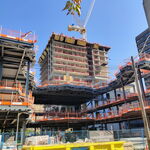Alot of this is incorrect, IIRC the SRT has the best on-time performance of any Toronto RT line. Any reliability issues with the cars are due to the fact that they were the first ones manufactured. There have been 5 generational improvements since. ICTS also doesn't have higher signalling costs assuming you aren't going to install fixed block for any new subway.
The Canada Line is not ICTS so I don't know your point there....
The costs are certainly lower if you are only using one verses 2 TBMS.
You can state that the SRT has the "best on-time" performance of any Toronto RT line without looking at statistics and I won't believe you. Here are the delay times for each subway line and the number of delays for each subway station sorted by line:
The most recent CEO's report confirms these numbers
https://www.ttc.ca/About_the_TTC/Co...cutive_Officer's_Report_March_2018_Update.pdf
The original numbers were taken from the Open Toronto, and include delays between 2014-2017(1st quarter). First off, we notice that the average number of delays per station is lowest for the Sheppard Subway, not the SRT. Second, we also notice that the average delay time per station is actually HIGHEST for the SRT by a margin of about 600 delay minutes per station. This is followed by the Bloor Danforth Line, The YUS line, and the Sheppard Line. Therefore, this statement that "The SRT has the best on-time performance of any Toronto RT line" is a flat-out lie.
Second, you cannot compare the SRT's delay numbers with other lines and say that the technology runs better as a result. If one hasn't noticed, Lines 1 and 2 are about 5* as long as the SRT, making it more prone to significant knock-on effects. It should also be mentioned that the infrastructure on Lines 1 and 2 are about twice the age of the SRT, making the infrastructure a good indicator of delays, not the technology itself. The CEO's report indicates that the TR trains are having mean distances between failures of:
Which is quite impressive. The SRT trains don't have values which is unfortunate, but it clearly shows high reliability in the subway cars (they vary month to month due to weather conditions and human interaction with the cars. Just in January, the mean distance between failures for the TR cars was around 1.2 Million km).
Vancouver doesn't give out any information regarding the reliability of the cars they have, but I can guarantee that they will be higher than what is here because it has a completely different climate.
We're talking about the Sheppard Subway, which was built with fixed block signal systems and would have used Mark II trains under your assumption. We have no experience with those cars here but we can safely say that it still would have been more expensive to build a line with that equipment because a new yard would need to be built to accommodate them, and since this is in North York, that would have been extremely expensive.
The original argument was against the Canada line's capacity, and that building trains a line that can only accommodate 2 car trains is going to be much less expensive than one with 6 or 8 car ART trains. The capacities you were originally quoting implied 6-8 car ART trains, at which point, you would be building a subway. I argued that it makes no sense to build a line with a different technology, as it would require a new yard, could not have redundancies with other lines, etc.
There's no doubt about that, but you can only use 1 tbm when the geography allows for it. The use of 1 tbm also requires that tunnels be built deeper, which may not be a feasible option with the Sheppard subway.






